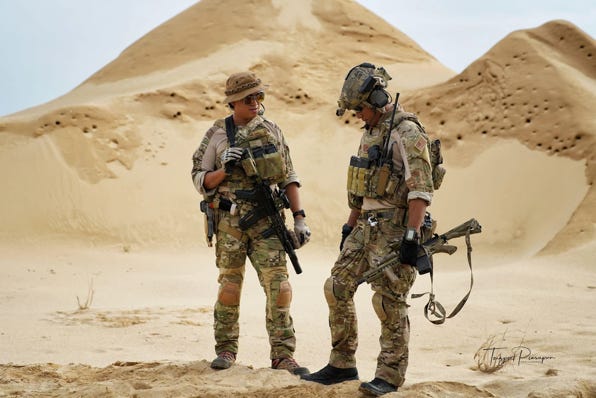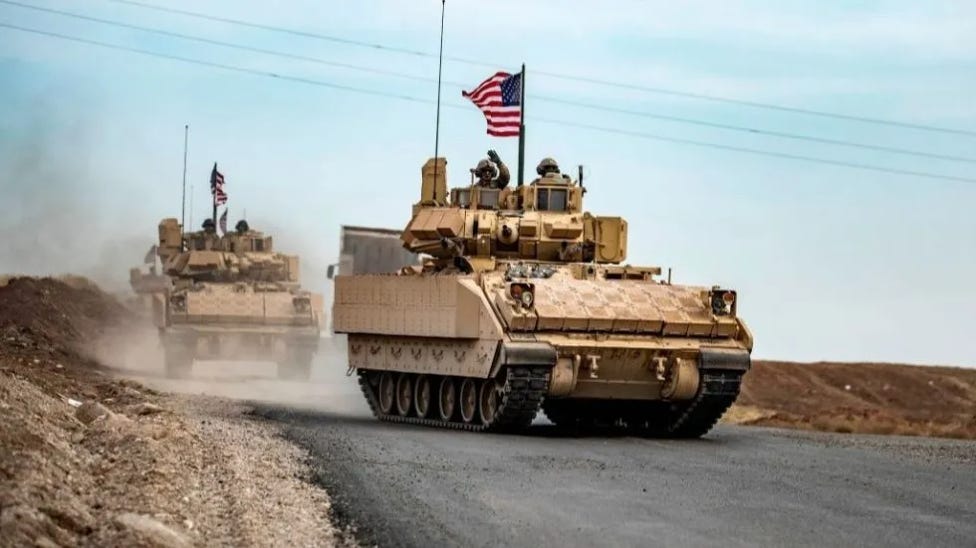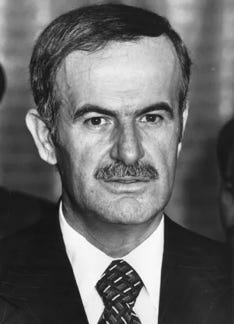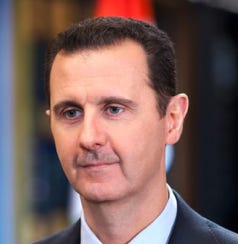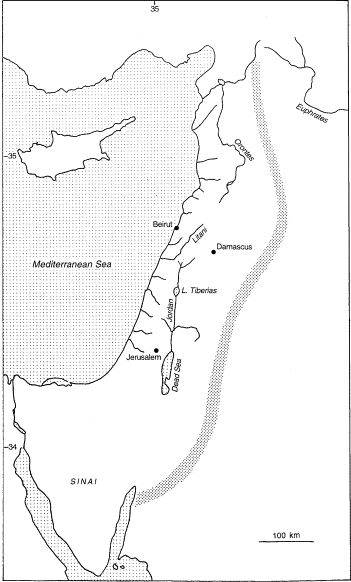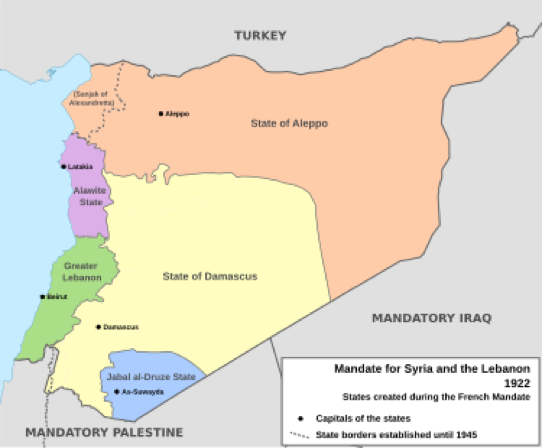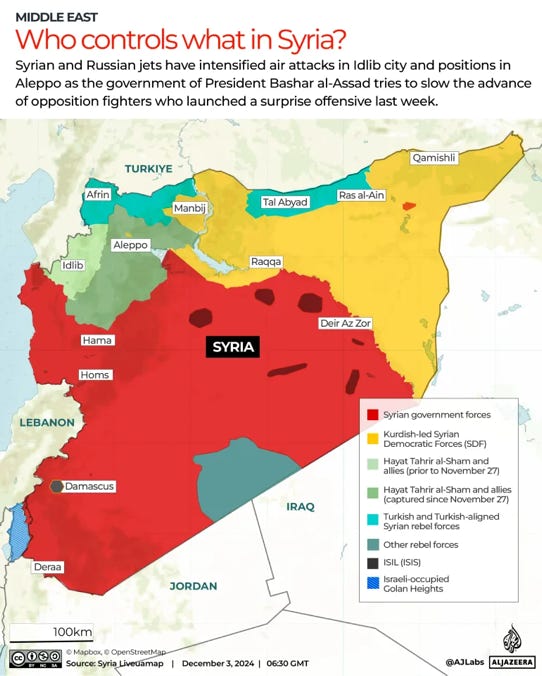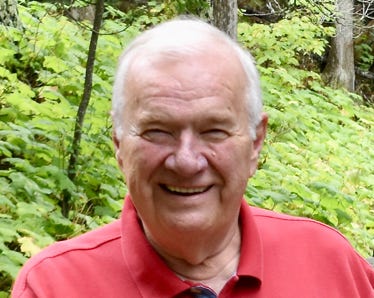DUTY, HONOR, COURAGE, RESILIANCE
Talking Proud: Service & Sacrifice
Syria: A fractured state
Venture into the unfamiliar
Introduction
Syria and US military involvement in Syria jumped onto my radar screen on December 8, 2024, when an Islamic paramilitary organization known as Hayat Tahrir al-Sham (HTS) overthrew the Syrian Bashar al-Assad government of Syria, which many felt could not be done. The US had declared HTS to be a foreign terrorist organization, which vexed me further.
About two weeks later, on December 19, 2024, the Department of Defense (DoD) announced that there were about 2,000 US military members in Syria, more than twice the 900 it had previously acknowledged. What? Why?
I had paid scant attention to Syria over the years. This DoD announcement made me examine Syria as closely as a “rookie” like me can do. Boy, oh boy, what a mess.
I feel a bit like Humpty Dumpty, fearing that I could not, perhaps have not, put Humpty Dumpty together again. This is my report; it is a primer, an introductory report in which I share what I have learned with those who may not know much about Syria. I do not profess to be an expert; I aim to understand why US military forces are in Syria, on the ground. I cover the period 2011 to 2024.
I have ventured into the unfamiliar. Come in with me.
Rick Francona, a retired USAF officer and former member of the Defense Attaché staff at the US embassy in Damascus, and a digital acquaintance, has said,
“The situation in Syria is in complete disarray and changing by the hour.”
Tim Lister, reporting for CNN, hit the nail on the head from where I sit,
That is so true. While doing this report, I learned that more stones had to be turned beneath every stone of knowledge that I turned.
Although Syria appears to have a new governing authority, the country is impoverished, with large segments of its territory occupied by foreign military forces and multiple armed militias often beholding to various foreign powers and centers of gravity.
President Trump has called Syria a mess, and I agree. He has also said he wants to withdraw, which is understandable. The question is whether a US withdrawal is workable and if it is in the US's national security interests.
Demographics of Syria
It is hard to obtain an accurate count of the Syrian population. Demographic data has often proved unreliable. The country has long been riddled with despotic rule, civil war, rebellious and violent militias, influxes of refugees, outflows of citizens, internally displaced people, prisoners, and wartime casualties. For the sake of discussion, I accept DW’s assessment that the number living in Syria is between 23 and 25 million.
Most Syrians are Arab Muslims; perhaps 70 percent are Sunni Muslims. Shi’a Muslims are a slim minority. Alawites, who long ago split from Shi’a, are a more significant minority, possibly 12%.
Syria also hosts Christian religious minorities and multiple ethnic minorities, including Kurd, Iraqi, Palestinian, Armenian, and Greek groups.
It is well worth recalling that the territory now known as Syria was part of the Ottoman Empire before WWI. To put this in perspective, Syria was part of the Ottoman Empire when the US declared its independence in 1776.
Syria achieved independence from France in 1946 after WWII. However, it was politically unstable after independence. Pushing for self-determination is a tricky business, and so it was for Syria, which hosted many different social, religious, and political entities. Syria joined Egypt to form the United Arab Republic in 1958 but declared itself independent in 1961, and it was named the Syrian Arab Republic.
The Ba’ath political party, dedicated to forming a single Arab socialist nation, was founded in 1943 in Damascus and took power in 1963. The country devolved into great turmoil, and Hafez al-Assad, an Alawite military officer, took power in 1970 and was elected president in 1971.
Hafez al-Assad died in 2000, and his son, Bashar al-Assad, a doctor of ophthalmology, became president. He ruled until December 8, 2024. The Alawites have been politically dominant mainly because the Assad family ruled from 1971 to 2024, ruled ruthlessly, I might add.
Hay’at Tahrir al-Sam (HTS), a rebel group with ties to al-Qaeda, took power. At this writing, HTS is trying to establish a transitional government of some sort. One of its many challenges is that most in the West, the US included, view HTS as a terrorist organization.
Arabic has been the official language, though many others are spoken based on ethnicity and the economic demand to speak English and French. I have seen reports that say 17 languages are spoken in Syria.
Most people live in Syria’s western coastal region, which is part of the Levant. It is a geographic region, the eastern shoreline of the Mediterranean. TGhis triggers a thought to keep in mind as you proceed.
Levant is a term used by civilization for thousands of years and has referred to different areas at different times. It has little regard for today's national boundaries.
This, in turn, raises the question of artificial states, states where political borders do not correlate with divisions of people desired by those people, whether ethnic, religious, and/or linguistic etc. Artificial states are a result of colonization and post-war treaties that failed to recognize claims on the lands made previously by various groups of people. They were formed “without any respect for people’s aspirations.” Iraq and Syria stand out as artificial states.
The victors of WWI, known as “the Powers,” including the US, Great Britain, and France established a system of mandates that reflected who controlled what territories. Syria and Lebanon, often called the Levant States, were in the French mandate that divided the Ottoman Empire.
The French governed several territories in this mandate, including the States of Allepo, Damascus, Jabal al-Druze, Alawite, the Sanjak of Alexandretta, and Greater Lebanon. France gave Alexandretta to Turkey in 1939. The states of Allepo, Damascus, Jabal al-Druze, and Alawite were incorporated into Syria after WWII, and Lebanon too was created as an independent state.
I find Syria to be an artificial state. That said, it is internationally recognized and a member of the UN.
More than half of Syrians live in cities in the west and the Euphrates River Valley in the east. Damascus, Aleppo, and Homs are the country’s largest cities. The population is said to be young, with a median age of 23, and the population in the cities is dense.
The western coastal region is arable and fertile, as are the Euphrates River Valley and its tributary, the Khabur River Valley. Both rivers flow southward from Turkey. However, much of Syria’s center is a hot, dry, and rugged desert, known as the Bādiyat Al-Shām, or Badiya,
Syria: A fractured state
Today’s Syria is a fractured state, beset by conflict and economic misery. There are more organizations, groups, coalitions, and militias fighting in Syria than you can shake a stick at.
I’ll borrow a map from Aljazeera, a Qatari-funded news outlet, to introduce you to the fractures in Syria as of December 3, 2024. I will address most of these fractures in the following sections of this report.
- Syrian Arab Republic, the Syrian state between 1963 and 2024, one-party Arab Socialist Ba’ath Party, a personalized dictatorship ruled by the Assad family, most recently by President Bashar al-Assad, an Alawite, a sect of Islam splintered from Shi’a Muslims.
- Syrian Democratic Forces (SDF), formed in 2015, a Kurdish-led coalition of US-backed left-wing ethnic and Arab militias that serves as the official military wing of the Autonomous Administration of North and East Syria (AANES), unofficially known as Rojava and West Kurdistan. Allied with the US.
- Hayat Tahrir al-Sham (HTS), a rebel group that says it is in charge in Damascus, AKA the Levant Liberation Organization. It was formed in 2017 and is a Sunni Islamist Organization; it is considered a terrorist organization by the UN, the US, and many others. HTS grew out of the al-Nusrah Front, which is tied to al-Qaeda. As of December 9, 2024, HTS claimed to be in charge of Syria as a transitional government.
- Al-Nusrah Front: Formed in 2012, an aggressive rebel organization seeking unification of Islamist forces intending to conquer the Levant. Tied to al-Qaeda. The US considers it a terrorist organization.
- Free Syrian Army (FSA): Syrian rebel forces founded in 2011 by officers who had left the Syrian Armed Forces (SAF). Intended to be the armed wing of the Syrian revolution. Largely dependent on Turkey for sanctuary and supplies. Often viewed as the Turkish-backed FSA.
- Islamic State: Pro-Sunni group once affiliated with al-Qaeda seeking to establish a global Islamic caliphate under the leadership of a caliph, a person seen as the political and religious successor to Mohammed. Designated as a terrorist organization. Many call it Islamic State, using the acronym “IS” for short. Some call it the Islamic State of Iraq and Syria (ISIS), others the Islamic State of Iraq and the Levant (ISIL), the Islamic State of Iraq and al-Sham (ISI and ISIS), and finally, Daesh. I use the term Islamic State (IS), but when I quote someone, I’ll quote the terms they use. For my purposes, they are all the same.
The Syrian civil war of 2012 caused many other groups to form, too many to mention here. Wikipedia does a yeoman’s job of highlighting many. I commend its outline to you.
Multiple foreign powers have entered the fray, beginning with unarmed uprisings against al-Assad in March 2011, which turned into an all-out civil war in the country. The leading players include,
- United States, allied with the SDF and using the SDF as its proxy ground force in Syria. Provides US air power and several thousand US ground forces in Syria, all focused on degrading and defeating the IS, an organization that could threaten the American homeland. Established base camps throughout eastern and southern Syria. Sought the overthrow of the Assad regime.
- Russia, allied with the Syrian Arab Republic and leadership of Bashar al-Assad. Provides Russian air power and ground forces to support the Assad regime. Seeks to cause the US to leave Syria. Established an air base using the Assad International Airport near Latakia in western Syria and a naval facility on the Mediterranean Sea at Tartus to provide air support to pro-Assad forces and obtain maritime access to the Mediterranean Sea.
- Turkey allied with the FSA to overthrow the Assad regime. Intervened militarily in the Syrian civil war.Focused on preventing the Kurdish population and organizations from threatening Turkey’s southern border. Seeks to persuade the US, a NATO ally, to leave Syria and to obtain a pole position in Syrian affairs.
- Iran joined with Russia to prop up the Assad regime. Supports proxy Syrian and Iraqi Shi’a militias as well as those from other Islamic countries against US ground forces deployed to Syria. Goal is to connect Iran to the Mediterranean Sea through Iraq, Syria, and Lebanon. Hopes to cause the withdrawal of US forces and to support proxy forces in Lebanon, such as Hezbollah, in its fight against Israel.
- Jordan shares a border with southern Syria, where its military forces have clashed with Syrian forces. Opposed the Assad government and saw Iran’s involvement as a threat to Jordan. Quietly supports the US intervention in Syria.
- Israel invaded the buffer zone between Syria and the Israeli-occupied Golan Heights, established bases in this buffer zone, and conducted air attacks against Assad military forces, hoping to prevent the transfer of their capabilities to militias intent on attacking Israel, whether through the Golan Heights or Lebanon.
- Great Britain supported groups opposed to the Assad regime and joined US military forces to provide air power to attack IS targets.
- France has roots in Syria through the mandate system. Insisted that the Assad government step down at the outbreak of civil war in 2011 and has provided support to opposition forces. Joined with the US and Britain to conduct air attacks against IS targets. French ground forces have used bases in Syria against IS.
I will add that various militias hold tens of thousands of prisoners in jails of all kinds across the country. Furthermore, there are several million internally displaced people and many thousands of refugees. Together, these prisons and refugee camps create a hostile environment that will impact Syria in the future. Finally, estimates show that eight to thirteen million Syrians live outside Syria.
It is remarkable that Syria can function at all.
Saddle up. Let’s get started.
Click to zoom graphic-photo
